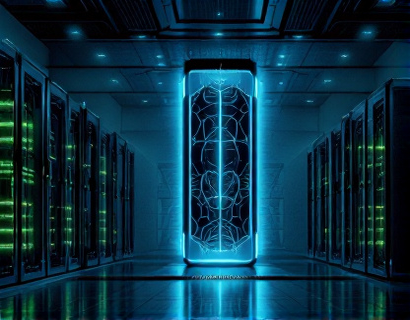Blockchain-Enhanced Registry Software: Revolutionizing Data Management with Security, Transparency, and Efficiency
In the rapidly evolving landscape of data management, the integration of blockchain technology has emerged as a transformative force, offering unparalleled security, transparency, and efficiency. This article delves into the profound impact of blockchain-enabled registry software, designed to revolutionize how professionals and enthusiasts approach data management. By leveraging the inherent properties of blockchain, such as decentralization, immutability, and cryptographic security, this software not only streamlines registry processes but also builds trust and accountability across various sectors.
Understanding Blockchain Technology in Registry Management
To fully appreciate the benefits of blockchain-enhanced registry software, it is essential to understand the fundamental principles of blockchain technology. At its core, a blockchain is a distributed ledger that records transactions across multiple computers in such a way that the registered transactions cannot be altered retroactively. This ensures data integrity and transparency, as every transaction is verified and added to a block, which is then linked to the previous block, forming a chain.
The decentralized nature of blockchain means there is no single point of failure, making it highly resilient against cyber attacks and data breaches. Each participant in the network has a copy of the entire ledger, ensuring that all transactions are transparent and verifiable. This level of transparency is particularly valuable in registry management, where accuracy and trust are paramount.
Enhanced Security Through Blockchain
Security is the cornerstone of any data management system, and blockchain technology offers robust security features that traditional systems cannot match. The cryptographic algorithms used in blockchain ensure that data is encrypted and secure from unauthorized access. Each block in the chain is linked through a hash, a unique digital fingerprint, which makes it nearly impossible to alter any data without detection.
In a blockchain-enabled registry, data entries are immutable once recorded. Any attempt to modify a record would require altering all subsequent blocks, a task that is computationally infeasible due to the consensus mechanisms in place. This immutability ensures that historical data remains intact and trustworthy, providing a reliable audit trail for regulatory compliance and internal audits.
Transparency and Trust in Registry Management
Transparency is another critical aspect of blockchain technology that significantly benefits registry management. In traditional systems, data is often siloed and controlled by a central authority, leading to issues of trust and accountability. Blockchain's decentralized nature removes these barriers, allowing all stakeholders to access and verify data in real-time.
This transparency fosters trust among users, as they can independently validate transactions and data entries. For professionals in data management, this means reduced disputes and increased efficiency, as conflicts can be resolved quickly and transparently. Moreover, the visibility of the entire transaction history enhances accountability, ensuring that all actions are traceable and justifiable.
Efficiency and Streamlined Processes
Blockchain-enhanced registry software not only secures and transparently manages data but also significantly improves operational efficiency. By automating many manual processes through smart contracts, the software reduces the need for intermediaries and manual interventions. Smart contracts are self-executing contracts with the terms of the agreement directly written into code, ensuring that transactions are executed only when predefined conditions are met.
This automation streamlines workflows, reduces administrative burdens, and accelerates processes. For instance, in property registry management, blockchain can automate the transfer of ownership, reducing the time and cost associated with traditional paper-based systems. Similarly, in intellectual property management, blockchain can streamline the registration and licensing processes, ensuring that creators are promptly and accurately compensated.
Use Cases Across Various Sectors
The applications of blockchain-enhanced registry software are vast and varied, spanning multiple industries. In the government sector, blockchain can transform land registry systems, voting processes, and public record management, enhancing transparency and reducing corruption. For businesses, blockchain can optimize supply chain management by providing a tamper-proof record of product origins and movements, ensuring authenticity and quality.
In the healthcare industry, blockchain can secure patient records, ensuring privacy and compliance with regulations while enabling seamless data sharing among healthcare providers. For artists and creators, blockchain can provide a secure and transparent way to manage copyrights and royalties, eliminating disputes and ensuring fair compensation.
Challenges and Considerations
While the benefits of blockchain-enhanced registry software are clear, there are also challenges and considerations that organizations must address. One of the primary concerns is scalability. Current blockchain technologies, particularly public blockchains, can face performance issues as the number of transactions increases. However, advancements in blockchain architecture, such as sharding and layer 2 solutions, are addressing these scalability challenges.
Another consideration is the regulatory landscape. As blockchain technology is still relatively new, regulatory frameworks are evolving. Organizations must stay informed about local and international regulations to ensure compliance. Additionally, the integration of blockchain with existing systems requires careful planning and expertise to avoid disruptions and ensure seamless operation.
Future Prospects and Innovations
The future of blockchain-enhanced registry software is promising, with ongoing innovations set to further enhance its capabilities. The development of private and consortium blockchains offers a balance between decentralization and control, making them suitable for enterprise use cases. These tailored blockchains can be customized to meet specific industry requirements, ensuring optimal performance and security.
Interoperability is another area of focus, with efforts to enable different blockchain systems to communicate and share data seamlessly. This will facilitate a more connected and efficient ecosystem, where data can flow freely and securely across various platforms and industries.
Conclusion
Blockchain-enhanced registry software represents a significant leap forward in data management, offering unparalleled security, transparency, and efficiency. By embracing this technology, organizations can streamline their processes, build trust, and stay ahead in a data-driven world. As the technology continues to evolve, the potential applications and benefits will only grow, making blockchain an essential tool for professionals and enthusiasts alike in the realms of data management, security, and digital transformation.










































